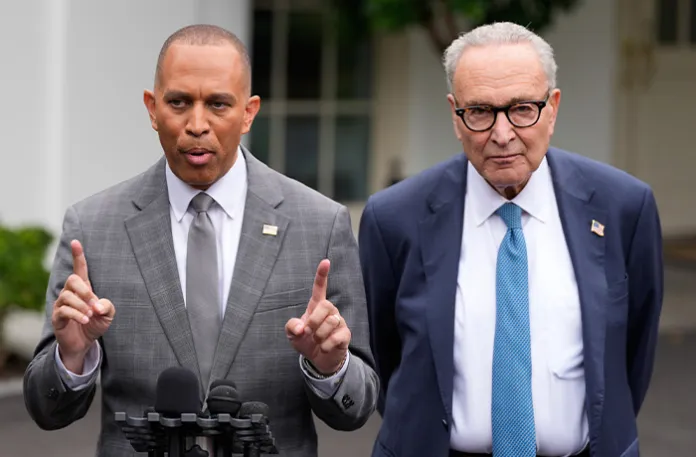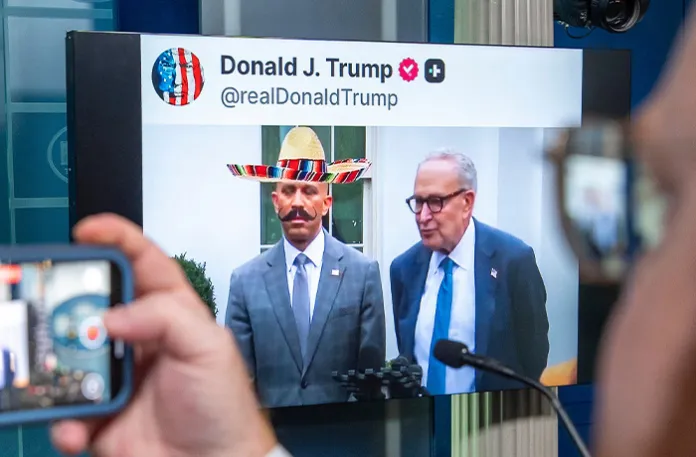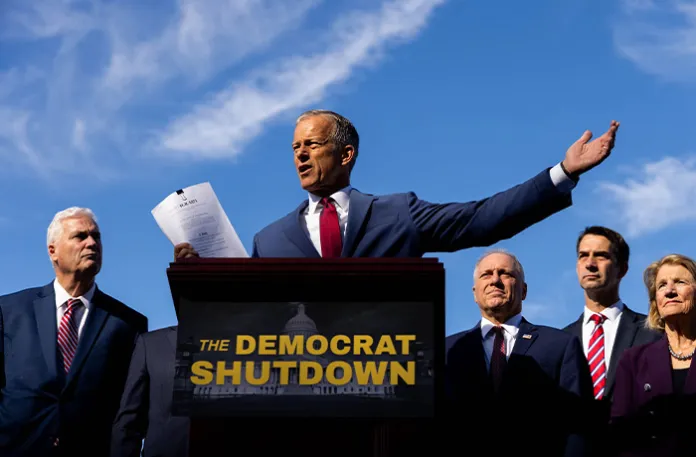Early in former President Barack Obama’s second term, the Republican-controlled House, backed by outside conservative groups and some of the most vocal elements of the Senate GOP minority, sought to defund his signature legislative achievement, using a government shutdown as leverage.
Republicans had campaigned on repealing the Affordable Care Act, better known as Obamacare, from virtually the moment it became law. There was a straight line from what then-Vice President Joe Biden hailed as a “big f***ing deal” and what Obama later described as a “shellacking” in the 2010 midterm elections. Republicans toppled the Democrats’ huge House majority and seized the speaker’s gavel from Nancy Pelosi (D-CA) by gaining 63 seats, mostly by running on a pro-repeal message.
But Obama recovered and was reelected anyway, albeit with a smaller margin of victory than four years earlier. The window for repeal seemed to be closing. But then conservatives on Capitol Hill, and their tea party allies throughout the country, had another idea.

In late September 2013, Sen. Ted Cruz (R-TX) spent 21 hours railing against Obamacare on the Senate floor. He had previously identified the urgency of defunding the healthcare law right then and there. And he was going to hold up federal funding, triggering a shutdown, to do it.
“President Obama’s strategy is simple: On Jan. 1, the subsidies kick in,” Cruz warned. “President Obama wants to get as many Americans addicted to the subsidies because he knows that in modern times, no major entitlement has ever been implemented and then unwound.” Cruz was right, but that shutdown lasted 16 days, and Obamacare was still with us.
Democrats are in an even weaker position in the current shutdown than Republicans were during the Obamacare defunding fight. In 2013, the GOP at least controlled the House. Democrats currently control nothing at the federal level. They are blocking a continuing resolution to keep the government open by using their filibuster power in the Senate, a procedural rule many of them spent most of the Biden administration decrying as anachronistic, undemocratic, and even racist.
Nor are the Democrats entirely unified. Three senators who caucus with the party have already broken ranks, voting more than once with nearly all Republicans to pass a funding bill that would end the shutdown. Sen. Rand Paul (R-KY) has been the lone GOP dissenter.
But this is the latest sign of a tea party-like uprising developing within the Democratic Party. Rank-and-file progressive Democrats are angry. They believe their party’s leadership is weak. They are frustrated with the Resistance’s lack of success, well, resisting President Donald Trump. They were convinced Trump was spent as a political force at the end of his first term. Now he is back in the White House, mocking them with memes of their leaders donning sombreros and real pictures of them sitting near “Trump 2028” baseball caps.

Senate Minority Leader Chuck Schumer (D-NY) is in a difficult position. When Sen. Dick Durbin (D-IL) retires, he will effectively be the last of the party’s old guard still clinging to a leadership position. (Although Pelosi still seems more powerful after surrendering her leadership position than many of her successors.)
While neither party’s congressional leadership is wildly popular with the voters, Schumer’s numbers are uniquely bad. A Pew Research Center poll found that 50% of respondents have an unfavorable view of him compared to just 21% who view him favorably. Vast swaths of the electorate have no opinion of either House Speaker Mike Johnson (R-LA) or House Minority Leader Hakeem Jeffries (D-NY). A majority has never heard of Senate Majority Leader John Thune (R-SD), the newest of the bunch.
Part of Schumer’s problem is that he is now disliked by both liberals and conservatives, as even his home-state electorate is moving away from him. Whether Rep. Alexandria Ocasio-Cortez (D-NY) mounts a primary challenge against him or not, she is clearly more influential within their party than Schumer. Socialist Zohran Mamdani defeated former Gov. Andrew Cuomo in the Democratic primary for New York City mayor and is heavily favored to beat him again in November.
With Biden having shuffled off into retirement, after being more or less overthrown as the 2024 Democratic nominee, Schumer has come to symbolize everything liberals dislike about their party: He’s older (74) and committed to political tactics that don’t work as well in the Trump era. Again, like the tea partiers more than a decade ago, they feel their party is stuck abiding by Marquess of Queensberry rules while the other side shreds every norm or convention. The times call not for Tip O’Neill toasting Ronald Reagan, they maintain, but bareknuckled political combat against a pugilistic president.
Establishment Democrats like Schumer have made their problems worse by firing up the base with talk of Trump and the Republicans posing a fascistic threat to democracy and then not really doing anything that suggests they really believe it. Before the debate disaster, the Biden reelection campaign wanted to make the defense of democracy central to its message but otherwise displayed no sense of urgency about the race, even as the polls began to show Trump leading.

This also has parallels to grassroots conservatives’ lack of confidence in Republican leadership during the tea party years. Republicans spoke of Obama as if he were tearing up the Constitution on the campaign trail but then largely seemed unfazed about losing to him.
When the country was last on the precipice of a shutdown in March, Schumer led a group of 10 Democratic senators from a mixture of battleground and safe blue states in passing a bipartisan funding bill. The progressive reaction was fierce, and it briefly looked like Schumer’s hold on his leadership position was in jeopardy.
Now he is racing to catch up with, rather than lead, the left-wing parade.
On the shutdown, it has already led to a bit of a partisan role reversal. “For years, every single one of us, we can remember Barack Obama on the White House lawn, we can remember Chuck Schumer, we can remember Nancy Pelosi for years, in Chuck Schumer’s case for literally decades, we’ve heard them say you don’t shut the government down over policy disagreement,” Vice President JD Vance told reporters at a White House press briefing, later adding, “For the first time since the Democrats have been in politics, they are now saying that unless we get every policy item that we demand, we’re going to shut down the people’s government. They’re trying to take a hostage. We’re not gonna let them.”
Even the Washington Post has likened the Democrats’ current shutdown posture to that of the conservative Freedom Caucus in the past. But a critical difference is that the progressive Democrats believe in activist government, whereas most members of the House conservative rump do not.
When, under Biden, the Green New Deal shrank into Build Back Better and then morphed into the woefully misnamed Inflation Reduction Act, progressive Democrats complained. But none of them tanked the bill because, ultimately, they wanted the new federal spending, even if they viewed it as insufficient. Obamacare itself was something progressives accepted, initially reluctantly, in lieu of being able to enact a totally government-run single-payer system.

Now the party of government is shutting the government down, and in the name of fighting Trump, it is giving his administration considerable control over how to prioritize paying the bills. Trump is already wielding this power over Democratic states and interests.
Perhaps Trump will overreach. At least in the near term, the involvement of budget director Russ Vought, of Project 2025 fame, in deciding what will happen next with the federal workforce seems to have Democrats angrily dug in. Democrats may be able to rely on a compliant media to shift the blame to Republicans, who after all run everything, as chaos ensues.
But it is a different media environment than the 1990s, when outlets such as the New York Daily News could move public opinion by reporting, “Newt’s tantrum: He closed down the government because Clinton made him sit at the back of the plane.” It’s not even 2013 anymore.
A New York Times-Siena College poll taken late last month showed weak support for the shutdown strategy. Only 27% said Democrats should shut down the government “if their demands are not met.” Democrats favored a shutdown by just 47% to 43%, while 59% of independents were opposed. It is not clear how much the Resistance activists really speak for most Democrats.
Democrats picked two shutdown fights during Trump’s previous term. The first lasted only two days, as red-state Democratic senators seeking reelection that year didn’t want to keep the government closed over an immigration policy dispute and promptly caved. But once the 2018 midterm elections were safely over and Democrats had done well, they were ready for the longest shutdown on record to thwart Trump’s border wall: nearly three dozen days.
HOW LONG CAN THE PARTY OF GOVERNMENT KEEP THE GOVERNMENT SHUT DOWN?
But no matter what happens with the government funding showdown, this tension within the Democratic Party will play out in primaries next year, ahead of the 2026 midterm elections. Progressive Democrats don’t yet have as many establishment scalps as the tea party movement, though it should be noted that success for the tea partiers did not always translate into general-election wins for the GOP.
Next year, progressives will see if they can improve their luck — and whether that actually redounds to the Democrats’ electoral benefit.

